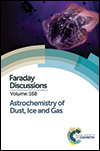THz and mid-IR spectroscopy of interstellar ice analogs: methyl and carboxylic acid groups
Abstract
A fundamental problem in astrochemistry concerns the synthesis and survival of complex organic molecules (COMs) throughout the process of star and planet formation. While it is generally accepted that most complex molecules and prebiotic species form in the solid phase on icy grain particles, a complete understanding of the formation pathways is still largely lacking. To take full advantage of the enormous number of available THz observations (e.g., Herschel Space Observatory, SOFIA, and ALMA), laboratory analogs must be studied systematically. Here, we present the THz (0.3–7.5 THz; 10–250 cm−1) and mid–IR (400–4000 cm−1) spectra of astrophysically-relevant species that share the same functional groups, including formic acid (HCOOH) and acetic acid (CH3COOH), and acetaldehyde (CH3CHO) and acetone ((CH3)2CO), compared to more abundant interstellar molecules such as water (H2O), methanol (CH3OH), and carbon monoxide (CO). A suite of pure and mixed binary ices are discussed. The effects on the spectra due to the composition and the structure of the ice at different temperatures are shown. Our results demonstrate that THz spectra are sensitive to reversible and irreversible transformations within the ice caused by thermal processing, suggesting that THz spectra can be used to study the composition, structure, and thermal history of interstellar ices. Moreover, the THz spectrum of an individual species depends on the functional group(s) within that molecule. Thus, future THz studies of different functional groups will help in characterizing the chemistry and physics of the interstellar medium (ISM).
- This article is part of the themed collection: Astrochemistry of Dust, Ice and Gas

 Please wait while we load your content...
Please wait while we load your content...